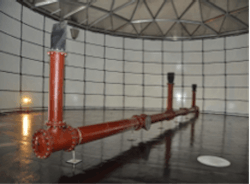Polar Vortex Is No Challenge for Tideflex TMS
The winter of 2013-2014 brought a “Polar Vortex,” a severe and sustained arctic blast that closed down business, schools, roads and airports, but the Tideflex® Mixing Systems (TMS) from Tideflex® Technologies kept ice from forming in tanks at a south central Pennsylvania Water Treatment Plant.
Record-breaking cold air broke low temperature records across the United States, including Pennsylvania, where temperatures fell to unprecedented levels, but the TMS kept the tanks mixed and prevented icing. After the region experienced sustained cold for 5-6 days, an operator working with the Borough Water Treatment Plant went to the top of one of their tanks, where the TMS was installed, to check on the condition of the tank. The operator said that there was, “Absolutely no icing.”
The Borough is approximately 5 square miles, and has an estimated population of 18,572. Raw water from a neighboring creek is treated at the Borough water treatment plant to deliver safe drinking water to the community. Continuous monitoring and laboratory testing is performed to assure that the highest quality water is being produced and distributed throughout the Borough and neighboring communities. Because of the treatment plant staff’s proactive monitoring and treatment practices, they have been awarded the Partnership for Safe Water Excellence in Water Treatment (Phase IV) Award. Only a handful of water systems throughout the country have demonstrated the capability and commitment to achieve this award.
When Planners for the community were looking to replace their buried rectangular reservoirs and floating covers, with new aboveground tanks, they knew they had to find a reliable and cost efficient mixing system. With Pennsylvania having such unpredictable weather, they also needed a system that could keep up with the varying climates. Treatment Plant Staff and their consulting engineer turned to the engineers at Tideflex® Technologies for a custom designed system solution. There was no question that the TMS was the way to go. TMS eliminates short-circuiting, water stagnation and achieves complete mixing in tanks. The maintenance free, single multiport manifold comprised of variable orifice Tideflex® Inlet Nozzles and Waterflex® Outlet Check Valves produces rapid and complete mixing that improves water quality. TMS is truly a “Green Technology”, requiring no additional energy source beyond the flow of water into the tank during the filling process. This provides an energy cost savings to the Borough when compared to other active tank mixing alternatives that may have been selected.
The TMS system was installed in the Borough’s East and West Tanks. A pump station pulls water out of the East and West Tanks where free chlorine is added prior to it entering the distribution system. Chlorine analyzers are utilized at the pump station as a part of the Borough’s quality control monitoring program. When the town had buried tanks, residual loss was a common problem. Now with the TMS system, chlorine residuals are elevated and very stable. The Borough Water Treatment Plant Manager, stated, “I have been able to trim back chlorine dosing” providing an additional cost-savings to the borough.
Always striving to maintain the highest quality water, the Borough operates their system to maximize tank volume turnover, which will minimize water age. The tank operating ranges stay relatively constant throughout the year, and do not fluctuate more than 9′, with the high water levels at 25′ and the low water levels around 16′.
The borough staff and consulting engineers were able to work closely with Tideflex® Technologies, a division of Red Valve Company to find the perfect solution and products to fulfill all their needs.
Photo: The new TMS Installed in the Above Ground Water Tanks


